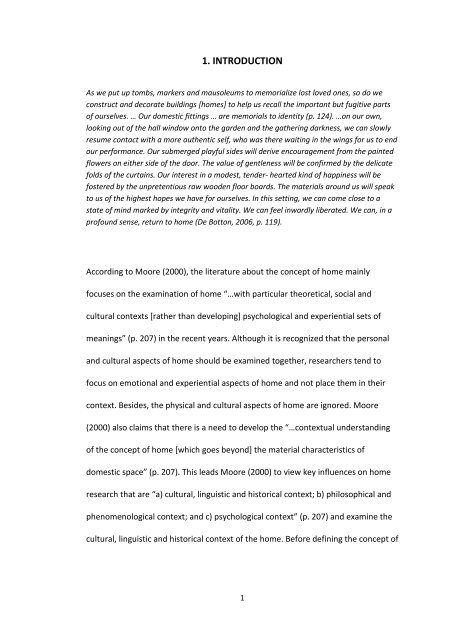private and public use of the living room - Bilkent University
private and public use of the living room - Bilkent University
private and public use of the living room - Bilkent University
Create successful ePaper yourself
Turn your PDF publications into a flip-book with our unique Google optimized e-Paper software.
1. INTRODUCTION<br />
As we put up tombs, markers <strong>and</strong> mausoleums to memorialize lost loved ones, so do we<br />
construct <strong>and</strong> decorate buildings [homes] to help us recall <strong>the</strong> important but fugitive parts<br />
<strong>of</strong> ourselves. … Our domestic fittings … are memorials to identity (p. 124). …on our own,<br />
looking out <strong>of</strong> <strong>the</strong> hall window onto <strong>the</strong> garden <strong>and</strong> <strong>the</strong> ga<strong>the</strong>ring darkness, we can slowly<br />
resume contact with a more au<strong>the</strong>ntic self, who was <strong>the</strong>re waiting in <strong>the</strong> wings for us to end<br />
our performance. Our submerged playful sides will derive encouragement from <strong>the</strong> painted<br />
flowers on ei<strong>the</strong>r side <strong>of</strong> <strong>the</strong> door. The value <strong>of</strong> gentleness will be confirmed by <strong>the</strong> delicate<br />
folds <strong>of</strong> <strong>the</strong> curtains. Our interest in a modest, tender- hearted kind <strong>of</strong> happiness will be<br />
fostered by <strong>the</strong> unpretentious raw wooden floor boards. The materials around us will speak<br />
to us <strong>of</strong> <strong>the</strong> highest hopes we have for ourselves. In this setting, we can come close to a<br />
state <strong>of</strong> mind marked by integrity <strong>and</strong> vitality. We can feel inwardly liberated. We can, in a<br />
pr<strong>of</strong>ound sense, return to home (De Botton, 2006, p. 119).<br />
According to Moore (2000), <strong>the</strong> literature about <strong>the</strong> concept <strong>of</strong> home mainly<br />
foc<strong>use</strong>s on <strong>the</strong> examination <strong>of</strong> home “…with particular <strong>the</strong>oretical, social <strong>and</strong><br />
cultural contexts [ra<strong>the</strong>r than developing] psychological <strong>and</strong> experiential sets <strong>of</strong><br />
meanings” (p. 207) in <strong>the</strong> recent years. Although it is recognized that <strong>the</strong> personal<br />
<strong>and</strong> cultural aspects <strong>of</strong> home should be examined toge<strong>the</strong>r, researchers tend to<br />
focus on emotional <strong>and</strong> experiential aspects <strong>of</strong> home <strong>and</strong> not place <strong>the</strong>m in <strong>the</strong>ir<br />
context. Besides, <strong>the</strong> physical <strong>and</strong> cultural aspects <strong>of</strong> home are ignored. Moore<br />
(2000) also claims that <strong>the</strong>re is a need to develop <strong>the</strong> “…contextual underst<strong>and</strong>ing<br />
<strong>of</strong> <strong>the</strong> concept <strong>of</strong> home [which goes beyond] <strong>the</strong> material characteristics <strong>of</strong><br />
domestic space” (p. 207). This leads Moore (2000) to view key influences on home<br />
research that are “a) cultural, linguistic <strong>and</strong> historical context; b) philosophical <strong>and</strong><br />
phenomenological context; <strong>and</strong> c) psychological context” (p. 207) <strong>and</strong> examine <strong>the</strong><br />
cultural, linguistic <strong>and</strong> historical context <strong>of</strong> <strong>the</strong> home. Before defining <strong>the</strong> concept <strong>of</strong><br />
1
















